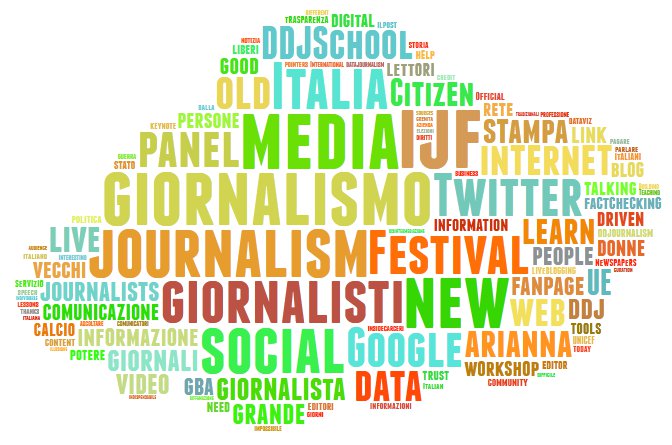 The panel by Matthew Ingram, was one of the main events that attracted attention during the day. This was confirmed by the peak of the tweets, that were reached during his speech. In particular, there were five key points that traditional media could learn, from new media. These key points explained the evolution that is going on in the information ecosystem.
The panel by Matthew Ingram, was one of the main events that attracted attention during the day. This was confirmed by the peak of the tweets, that were reached during his speech. In particular, there were five key points that traditional media could learn, from new media. These key points explained the evolution that is going on in the information ecosystem.
grande grande @margewi al #ijf13 ecco i 5 punti che gli old media devono apprendere dai new media! twitter.com/marisandralizz… — marisandra lizzi (@marisandralizzi) 26 aprile 2013
A mechanism of two ways in direction, has strongly emerged in this edition of the International journalism festival. In fact, the teachings coming from the new media to the traditional media, are much more. These teachings gives us the best suggestion ever, as the importance of “accuracy, accuracy, accuracy” is a famous quote said by Joseph Pulitzer. Another key event, has been the panel on 2.0 Business models, which focused on current difficulties in the information industry. Nowadays, it is difficult to balance revenues from print and digital media. Marco Bardazzi, digital editor of La Stampa, gave his outstanding contribution in a simple and effective way, identifying the fifth of the five “W’s”, “Why” is the element that distinguishes in the added value creation.
Delle 5 w 4 sono commodities oggi, e’ su Why [e how] che bisogna puntare dice @marcobardazzi a #ijf13 — Pier Luca Santoro (@pedroelrey) 26 aprile 2013
International Business development manager for WorldCrunch, Garret Goodman, has introduced the relatively unknown concept of “reverse paywall”, a business model that has introduced innovations, such as social sharing, as a form of payment by the readers.
. @garrettgoodman: “Con il reverse paywall, più l’utente è attivo (tweet, share…) più ha crediti per accedere al contenuto” #ijf13 — David Mammano (@mammanodavid) 26 aprile 2013
Do media outlets interact with Twitter users?
The map below, identifies the user interactions that were ongoing in the microblogging platform Twitter, during the first two days of the festival. As well as the fact that the map shows the central point being the International journalism festival account, it is also interesting to know that media and newspaper accounts, played a smaller role than people via the particular interactions, as confirmed during different panels in the days of the event. Instead single journalists play a significant role in an active interaction with their readership via Twitter. This phenomenon seems to move the attention from the news brand to the single professional value. 
Go to live monitoring BuzzFlow platform to zoom the map.
We confirmed a trend of growth in all the quantitive parameters analysed in the platform powered by Buzzdetector. 2,724 people have expressed their opinion and shared their interesting news relevant to the Journalism festival, contributing to a sum of 9,543 tweets. The maximum peak of tweets per minute is growing and had reached 161 tweets per minute during the speech by Matthew Ingram, late into the morning.  The Word Cloud of the most used terms on Twitter, highlights a strict correlation between journalism in social media. Citizen journalism, use of open data and the difficult relation between the information industry and Google were the other major topics during day 3.
The Word Cloud of the most used terms on Twitter, highlights a strict correlation between journalism in social media. Citizen journalism, use of open data and the difficult relation between the information industry and Google were the other major topics during day 3.
Analysis by
Angelo Centini, data scientist for Buzzdetector
Aarti C. Thobhani, freelance journalist and festival volunteer
Matteo Di Renzoni, freelance data journalist
Pier Luca Santoro, expert in Communication and Media
Gianandrea Facchini, CEO and Founder of Buzzdetector
Alessandro Belotti, journalist and festival volunteer

